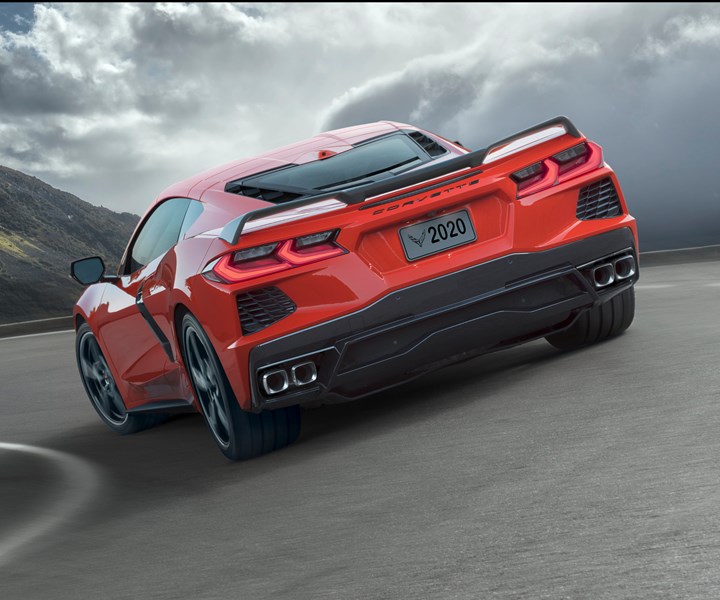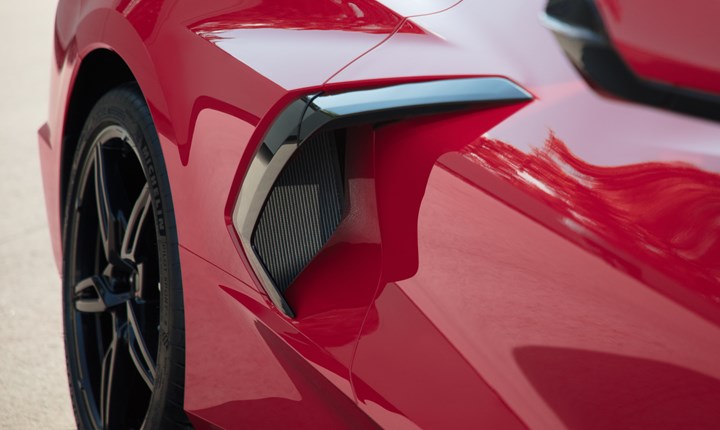Everything You Need to Know about the C8 Corvette
When you have the chief engineer talking about the Stingray, you truly learn everything

The 2020 Stingray: the most powerful Corvette ever. (All images Chevrolet)
When Car and Driver tested the 2020 Stingray they discovered, as Rich Ceppos writes, “the C8 rips to 60 mph in 2.8 seconds. That’s 1.1 seconds quicker than the C7 Z51. The C8 even betters the 60-mph runs of the quickest 650-hp C7 ZO6 and the 755-hp C7 ZR1 we tested. . . .”
Which is to say that the C8 is damned fast.
As Tadge Juechter, Executive Chief Engineer, Corvette, explains on this edition of “Autoline After Hours,” a key reason why this new car has a mid-engine configuration rather than the engine in the front (with the new one having a weight distribution of 60/40, rear to front, compared with the 50/50 of the C7) is because every new Corvette needs to be better than its predecessor, and they simply needed to modify the architecture in order to achieve that.
Which evidently they did. And then some.
A History Lesson
Juechter has been working on Corvettes since 1993—back at the time of the C5—and so he has helped contribute to the incremental—or maybe in the case of the ‘Vette the right word is substantial—improvements that have occurred over the years, improvements that have led to this Stingray.
Juechter talks about the development of the C8 with Autoline’s John McElroy, Greg Migliore of Autoblog and me.

Side vents help with the breathing for the 6.2-liter Small Block V8 LT2 engine that produces 495 hp when fitted with the performance exhaust.
He says that the genesis of the car goes back to 2005 when the mid-engine setup was determined to be something worth studying. An interesting aspect related to that—one that is an issue that many people who don’t develop things like the Corvette undoubtedly face—is that there was concern within General Motors that they’d be messing with something that was proving to be successful. Juechter points out that they don’t do clinics when developing Corvettes, so decisions about what to do have to be made largely by those who understand what a Corvette is.
A Mid-Engine Chevy
Certainly, there are plenty of mid-engine cars. Porsches, Ferraris, McLarens, and the like. And what these vehicles have in common is a window sticker that has bigger numbers than can be carried by a Chevy. If price were no object, he says, the engineering challenge would have been somewhat less daunting. To put it mildly. (The starting MSRP is $59,995. For many of the competitive vehicles there is an additional number to the right of the dollar sign.)
Juechter says that they benchmarked those cars, tore them down to see how they worked, then worked to figure out how they could make a vehicle that has the affordability that is required for a Corvette. He points out that while there are vehicles that don’t have engines under the hood in the history of GM—Corvair, Fiero—there aren’t people around who worked on them.
One of the big issues that Juechter says they worked on was managing airflow. The 6.2-liter V8 LT2 engine needs to breathe, as well as to have a means of exhaust, so for the former, they had to figure out ways to channel the air to the intake. The exhaust portion, of course, is more straightforward.

C8 engine under glass. Literally.
What’s more, they had to take into consideration the need for there to be storage for things like sets of golf clubs and luggage, as well as the standard removable roof. Not only is there a trunk in the rear, but there is a frunk in the front, providing a total 12.6-cubic feet of cargo capacity.
The Structural Challenge
The removable top, of course, means that all C8s are, in effect, convertibles (there is a “real” convertible model), which is a challenge when it comes to global stiffness of the vehicle. Juechter says that they’ve engineered the C8 to be the “stiffest ever,” using such things as an aluminum-intensive center structure design. It is worth pointing out that he says the vehicle is a “mosaic of materials,” as there is an array of different materials. For example, when it comes to composites, he says they use a range from pure glass to carbon fibers.

One reason for the configuration of the steering wheel: to prove a clear view of the 12-inch reconfigurable cluster display.
The array of things you’ll learn about the C8 is remarkable—everything from the shape of the steering wheel (not round) to why there is a dual-clutch automatic transmission and no manual (“We couldn’t find anyone who wanted to build a manual at a loss”).
And you can see it all here.


.jpg;width=70;height=70;mode=crop)